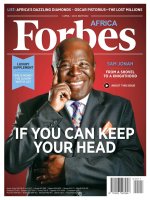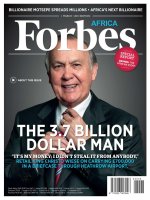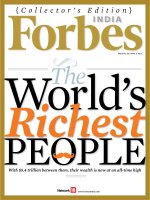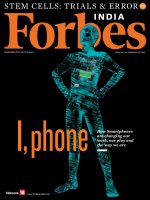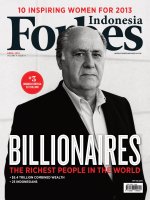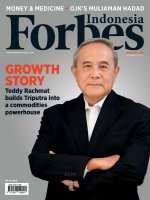Forbes USA 02 December 2013 (e magazine full)
Bạn đang xem bản rút gọn của tài liệu. Xem và tải ngay bản đầy đủ của tài liệu tại đây (37.97 MB, 128 trang )
Muhammad Yunus
Microloan pioneer, Nobel laureate—
and Forbes’ lifetime achievement
award winner for
social entrepreneurship.
p. 97
Paul Tudor Jones
Solving poverty at
home means solving
education.
p. 78
Bono
The rock star uses
commerce to raise
money—and fame to
sell governments.
p. 66
Bill Gates
The brains—and
wallet—behind the
fight against
preventable disease.
p. 66
Ellen Johnson
Sirleaf
Liberia’s
president, a
Nobel Peace
Prize winner,
embraces
altruistic
capitalism.
p. 98
ENTREPRENEURS
CAN SAVE
THE WORLD
GOVERNMENTS CAN’T ERASE POVERTY.
NOR CAN BIG CORPORATIONS.
THESE ARE THE PEOPLE AND IDEAS THAT ARE DOING IT.
WHY THE BULL MARKET WON’T STOP • NEXT BIG SPECTATOR SPORT: VIDEOGAMES
DECEMBER 2 • 2013 EDITION
SPECIAL
PHILANTHROPY
ISSUE
Ray Chambers
From The Forbes 400
to the world’s point
man on malaria
and AIDS.
p. 109
Jef Skoll
Taking action by
telling stories.
p. 54
Patrice and Precious Motsepe
The first African billionaires to
join the Giving Pledge.
p. 112
Francine LeFrak
How a failed
movie turned into
a job program for
Rwanda’s poor.
p. 110
EXCLUSIVE:
THE TOP 50
PHILANTHROPISTS
WHO ACTUALLY
GAVE MONEY
(VERSUS JUST TALK ABOUT IT)
ROBIN HOOD,
REINVENTED:
WALL STREET’S
FAVORITE CAUSE
CHANGES COURSE
PORTFOLIO:
THE BUSINESSPEOPLE
TURNING AROUND
POVERTY IN AFRICA
BILL GATES
AND BONO:
ON THEIR ALLIANCE OF
FORTUNE AND FAME
PLUS: BONO’S ODE
TO WARREN BUFFETT
Liesel Pritzker Simmons
The anti-Paris Hilton: An
heiress focuses her inheritance
on impact investing.
p. 86
Tsitsi Masiyiwa
Tapping a telecom fortune to
educate HIV orphans.
p. 106
Poverty Warriors:
1 rock star, 2 Nobel Peace
Prize winners, $100 billion
in net worth and an infinite
appetite for taking chances.
Photographed on June 5, 2013,
in the North Delegates’ Lounge
of the United Nations.
Dikembe Mutombo
An NBA windfall
becomes a
health care solution.
p. 107
®
©2013 John Paul Mitchell Systems
®
“Growing up, we didn’t have a lot of money, but my mother always grew her own vegetables.
Now we’re bringing generations together helping thousands of families help themselves with
Grow Appalachia’s community gardens.”
John Paul DeJoria, CEO and Co-founder
THE BEST IN PROFESSIONAL SALON HAIR CARE PRODUCTS
Guaranteed only in salons and Paul Mitchell Schools. paulmitchell.com
4 | FORBES DECEMBER 2, 2013
contents — DeceMBeR 2, 2013 VoLUMe 192 nUMBeR 8
66 | special report: philanthropy
Using the tools of capitalism to save the world’s poorest people.
cover photograph by michael prince for forbes
13 | FACT & COMMEnT
by steve forbes
The bankruptcy of modern economics.
LEADERBOARD
16
| MEGA MACAU
Transforming muddy swampland into the
world’s greatest casino town.
20 | SCORECARD
Williams fl ies; Zuckerberg loses friends.
22 | EMERGinG EnTREpREnEURS
African innovators developing technology
to make essential tasks easier.
Plus: FORBES makeover.
26 | THE wEALTHiEST AFRiCAnS
Ten tycoons in retail, oil, cement and more.
28 | ACTivE COnvERSATiOn
How powerful is Vladimir Putin?
66 | when bill met bono
Fame, fortune and fi nding
solutions. A conversation.
©2013 movado group, inc.
Powered by
Movado
ESQ fuSion AnD CATALYST
A NEW PERSPECTIVE ON MODERN DESIGN.
MEN’S FUSION DUAL-TIME WATCH AND
NEW CATALYST
™
CHRONOGRAPH.
ESQMOVADO.COM
JARED
®
THE GALLERIA OF JEWELRY
6 FORBES DECEMBER 2, 2013
contents — DeceMBeR 2, 2013
THOUGHT LEADERS
30 CURRENT EVENTS
by amity shlaes
Kennedy strikes back.
32 INNOVATION RULES
by rich karlgaard
Team management: Think small and agile.
34 CAPITAL FLOWS
by steven f. hayward
The shining city of exceptional immigrants.
STRATEGIES
36 THE ESPN OF VIDEOGAMES
Twitch has big-league audiences watching
e-Sports online. It has big advertisers, too.
by david m. ewalt
42
BIGGER THAN CRAISINS
Ocean Spray has a Yankee knack for squeezing
new dollars out of the same old cranberries.
by alexander konrad
TECHNOLOGY
46 PANDORA PLAYS NICE
The service that musicians love to hate
just wants the same deal as Apple.
by connie guglielmo
ENTREPRENEURS
50 AND BABY MAKES MONEY
4moms develops high-tech gear for infants.
Without a key pivot, it might still be making
showerheads.
by karsten strauss
54 POWER OF THE STORY
In Hollywood—or anywhere—narrative is still
the best way to inspire and compel change.
by jeffrey skoll
INVESTING
56 “YOU WANT A STOCK LIKE
MERYL STREEP”
Bill Smead likes to buy big brands that others
have given up on.
by abram brown
58 NICE TRICK FOR GOLD TRADERS
Smarting from a gold buy? Be clever with your
capital loss deduction.
by william baldwin
BrandVoice
by fidelity
Why Sector-Based Thinking
Matters to Investors. 59
60 FIXEDINCOME WATCH
by richard lehmann
Armageddon playbook.
36 | league of
their own
Next great spectator
sport? Videogames.
56 | contrarian’s closeup
Mutual fund star Bill Smead nabs
large companies on the cheap.
114 | contented
castaways
A $9 million booze-
cruise business.
46 | changing its tune
Pandora’s music royalty war.
*
Certain banking and brokerage accounts may be ineligible for real-time money movement, including but not limited to transfers to/from bank IRAs (CD, Money Market), 529s and Credit Cards and
transfers from IRAs, Loans (HELOC, LOC, Mortgage) and accounts held in the military bank. Merrill Edge is available through Merrill Lynch, Pierce, Fenner & Smith Incorporated (MLPF&S), and consists
of the Merrill Edge Advisory Center (investment guidance) and self-directed online investing. MLPF&S is a registered broker-dealer, Member SIPC and a wholly owned subsidiary of Bank of America
Corporation. Banking products are provided by Bank of America, N.A. and affi liated banks, Members FDIC and wholly owned subsidiaries of Bank of America Corporation.
Investment products:
Are Not FDIC Insured Are Not Bank Guaranteed May Lose Value © 2013 Bank of America Corporation. All rights reserved.
ARVPPYY7
Make real-time transfers
between investing and banking
accounts with Merrill Edge.
®
Investing for tomorrow is simpler with Merrill Edge. Log in once to
see your investment and bank accounts in one place and to instantly
transfer funds.* Simple fl at-rate pricing of $6.95. No minimum trades.
No minimum balances. Merrill Edge. It’s investing, streamlined.
merrilledge.com/streamlined
Bank with Bank of America.
Invest with Merrill Edge.
8 FORBES DECEMBER 2, 2013
contents — DeceMBeR 2, 2013
62 SMALL STOCKS
by jim oberweis
Little companies with big catalysts.
64 THE CONTRARIAN
by david dreman
Are stocks in for a sea change?
SPECIAL REPORT:
PHILANTHROPY
66 THE THINKER AND THE SALESMAN
The link between Bill Gates and Bono?
A capitalist’s outlook on solving global poverty.
by randall lane
78 ROBIN HOOD, REINVENTED
Paul Tudor Jones spent 25 years building a great
American foundation. Now he’s upending it.
by monte burke
BrandVoice
by samsung
An Alabama Community Responds to
Disaster With an Unusual
STEM Education Project. 81
86
THE ANTIPARIS HILTON
Liesel Pritzker Simmons ignited the breakup of one
of America’s great family fortunes. What she’s done
with the money is actually far more interesting.
by erin carlyle
94 THE PHILANTHROPIC 50
Exclusive: FORBES takes a hard look at the
numbers behind the world’s top philanthropists.
96 WARREN’S SONG
At the UN, Bono serenades Buett.
97 BANKER, BUILDER
Celebrating the groundbreaking work of
microfinance pioneer Muhammad Yunus.
by erin carlyle
98 A GRAND EXPERIMENT
Can entrepreneurial market-based philanthropy fix
one of the poorest spots on Earth?
by randall lane
106 HEARTS OF AFRICA
Meet six trailblazing philanthropists
lifting a continent out of poverty.
LIFE
114 SPRING BREAK FOR GROWNUPS
When the young and the auent want to blow o
steam in style, they head for Yacht Week.
by j.j. colao
120 THOUGHTS
On philanthropy.
78 | an education
Can Paul Tudor Jones fix America’s
broken public schools?
98 | nation builders
FORBES convenes a
philanthropic SWAT team
to help a troubled country.
86 | she’s all in
Liesel Pritzker Simmons,
Africa’s activist impact investor.
Spreading
the health.
The next few years
will see an explosion in
the number of people
entering the health
care system.
In fact, by 2016, as many as
33 million more adults will have
health insurance.
1
Plus, every day,
thousands of baby boomers will
become eligible for Medicare.
2
By joining forces with Coventry
Health Care, our footprint has
grown, allowing us to provide
coverage and access to care to
more Medicare, small-business
and individual customers than ever.
Now we can offer affordable, quality
coverage to more people in more
places — including a wider network
of providers, more cost-effective
business models and technology
that lets people take a more active
role in their health.
Covering more people
than ever. That’s our healthy.
What’s yours?
aetna.com/ourhealthy
1. Coverage Estimates, Congressional Budget Office, 2012
2. Baby Boomers Approach 65, Pew Social Trends, 2010
© 2013 Aetna Inc.
Health benefits and health insurance plans are offered
by Aetna Life Insurance Company and its affiliates (Aetna).
2013144
FORBES (ISSN 0015 6914) is published biweekly, except monthly in February, April, July, August and October, by Forbes LLC,
60 Fifth Ave., New York, NY 10011. Periodicals postage paid at New York, NY and at additional mailing oces. Canadian Agreement
No. 40036469. Return undeliverable Canadian addresses to APC Postal Logistics, LLC, 140 E. Union Ave, East Rutherford, NJ 07073.
Canada GST# 12576 9513 RT. POSTMASTER: Send address changes to Forbes Subscriber Service, P.O. Box 5471, Harlan, IA 51593-0971.
CONTACT INFORMATION
For Subscriptions: visit www.forbesmagazine.com; write Forbes Subscriber Service, P.O. Box 5471, Harlan, IA 51593-0971;
or call 1-515-284-0693. Prices: U.S.A., one year $59.95. Canada, one year C$89.95 (includes GST). We may make a portion of
our mailing list available to reputable firms. If you prefer that we not include your name, please write Forbes Subscriber Service.
For Back Issues: visit www.forbesmagazine.com; e-mail ; or call 1-212-367-4141.
For Article Reprints or Permission to use Forbes content including text, photos, illustrations, logos, and video:
visit www.forbesreprints.com; call PARS International at 1-212-221-9595; e-mail or e-mail
Permission to copy or republish articles can also be obtained through the Copyright Clearance Center at
www.copyright.com. Use of Forbes content without the express permission of Forbes or the copyright owner is expressly prohibited.
Copyright © 2013 Forbes LLC. All rights reserved.
Title is protected through a trademark registered with the U.S. Patent & Trademark Oce. Printed in the U.S.A.
CHIEF PRODUCT OFFICER
Lewis D’Vorkin
FORBES MAGAZINE
EDITOR
Randall Lane
EXECUTIVE EDITOR
Michael Noer
ART & DESIGN DIRECTOR
Robert Manseld
FORBES DIGITAL
VP, INVESTING EDITOR
Matt Schifrin
MANAGING EDITORS
Dan Bigman – Business, Tom Post – Entrepreneurs, Bruce Upbin – Technology and Wealth
SENIOR VP, PRODUCT DEVELOPMENT AND VIDEO
Andrea Spiegel
EXECUTIVE DIRECTOR, DIGITAL PROGRAMMING STRATEGY
Coates Bateman
EXECUTIVE PRODUCER
Frederick E. Allen – Leadership
Tim W. Ferguson FORBES ASIA
Kerry A. Dolan, Connie Guglielmo, Kashmir Hill SILICON VALLEY
Janet Novack WASHINGTON
Michael K. Ozanian SPORTSMONEY
Mark Decker, John Dobosz, Luisa Kroll, Deborah Markson-Katz DEPARTMENT HEADS
John Tamny OPINIONS
Kai Falkenberg EDITORIAL COUNSEL
BUSINESS
Mark Howard CHIEF REVENUE OFFICER
Tom Davis CHIEF MARKETING OFFICER
Charles Yardley PUBLISHER & MANAGING DIRECTOR FORBES EUROPE
Nina La France SENIOR VP, CONSUMER MARKETING & BUSINESS DEVELOPMENT
Miguel Forbes PRESIDENT, WORLDWIDE DEVELOPMENT
Jack Laschever PRESIDENT, FORBES CONFERENCES
Michael Dugan CHIEF TECHNOLOGY OFFICER
Elaine Fry SENIOR VP, M&D, CONTINUUM
FORBES MEDIA
Michael S. Perlis
PRESIDENT & CEO
Michael Federle CHIEF OPERATING OFFICER
Tom Callahan CHIEF FINANCIAL OFFICER
Will Adamopoulos CEO/ASIA FORBES MEDIA
PRESIDENT & PUBLISHER FORBES ASIA
Rich Karlgaard PUBLISHER
Moira Forbes PRESIDENT, FORBESWOMAN
MariaRosa Cartolano GENERAL COUNSEL
Margy Loftus SENIOR VP, HUMAN RESOURCES
Mia Carbonell SENIOR VP, CORPORATE COMMUNICATIONS
FOUNDED IN 1917
B.C. Forbes, Editor-in-Chief (191754)
Malcolm S. Forbes, Editor-in-Chief (195490)
James W. Michaels, Editor (196199)
William Baldwin, Editor (19992010)
10 FORBES DECEMBER 2, 2013
FORBES
IN BRIEF
EDITOR-IN-CHIEF
Steve Forbes
FORBES (ISSN 0015 6914) is published biweekly, except monthly in February, April, July, August and October, by Forbes LLC,
60 Fifth Ave., New York, NY 10011. Periodicals postage paid at New York, NY and at additional mailing oces. Canadian Agreement
No. 40036469. Return undeliverable Canadian addresses to APC Postal Logistics, LLC, 140 E. Union Ave, East Rutherford, NJ 07073.
Canada GST# 12576 9513 RT. POSTMASTER: Send address changes to Forbes Subscriber Service, P.O. Box 5471, Harlan, IA 51593-0971.
CONTACT INFORMATION
For Subscriptions: visit www.forbesmagazine.com; write Forbes Subscriber Service, P.O. Box 5471, Harlan, IA 51593-0971;
or call 1-515-284-0693. Prices: U.S.A., one year $59.95. Canada, one year C$89.95 (includes GST). We may make a portion of
our mailing list available to reputable firms. If you prefer that we not include your name, please write Forbes Subscriber Service.
For Back Issues: visit www.forbesmagazine.com; e-mail ; or call 1-212-367-4141.
For Article Reprints or Permission to use Forbes content including text, photos, illustrations, logos, and video:
visit www.forbesreprints.com; call PARS International at 1-212-221-9595; e-mail or e-mail
Permission to copy or republish articles can also be obtained through the Copyright Clearance Center at
www.copyright.com. Use of Forbes content without the express permission of Forbes or the copyright owner is expressly prohibited.
Copyright © 2013 Forbes LLC. All rights reserved.
Title is protected through a trademark registered with the U.S. Patent & Trademark Oce. Printed in the U.S.A.
dEcEmBER 2, 2013 — volumE 192 NumBER 8
A Golden Age
Of Philanthropy
BY RANDALL LANE
When FORBES rolled out its inaugural Philanthropy Issue
last fall, it provoked an unexpected reaction. Yes, there
were plenty of compliments, and constructive criticism,
too, but the overwhelming sentiment boiled down to this:
Please keep the conversation going.
This issue marks a step forward in honoring that re-
quest. A century ago, after America’s legendary genera-
tion of industrialists had created unprecedented fortunes,
these great entrepreneurs—led by Carnegie, Rockefeller
and Morgan—turned their formidable problem-solving
skills (and the entitlement to give that comes with mak-
ing money yourself ) on the era’s great social issues. With
innovations in technology and finance creating a wave of
disruptive megabillionaires, we’re now living through a
second golden age of philanthropy. And with the planet,
and its problems, now stitched together in ways incon-
ceivable in Carnegie’s time, this one has the potential to
be still more profound.
Governments no longer seem capable of executing big
ideas. Ditto for major corporations. It’s left to entrepre-
neurial capitalism to innovate. And modern- day philan-
thropy taps the same skills, substituting public good for
profits in instances where there’s not yet an economic
interest to do the right thing.
We centered this year’s issue on solutions for extreme
poverty, from America to Africa. While that’s a noble goal
worth focusing on, it’s also a prism to view the larger scope
of philanthropy, whatever your interest. There are lessons
here for anyone who believes in market-based, permanent
answers to large-scale problems.
F
EDITOR’S NOTE: Cognizant of the reaches of on-
line surveillance—and, more concretely, the fear
engendered among some people who provide us
information, we have introduced a Web-based
system for securely, anonymously sharing material
with our journalists. We’re calling it SafeSource.
Anyone can visit safesource.forbes.com and use
the anonymity software Tor to upload sensitive doc-
uments or messages for our reporters. If it all sounds
paranoid—well, that’s the idea. We want our sources
to be able to reach us with the highest standard of
security we can achieve.
Copyright © Unify GmbH & Co. KG, 2013
Connect.
Share.
Give.
Take.
Solve.
Save.
Smile.
Unify.
Introducing Unify.
Unifying business communications
for the new way to work.
unify.com
DECEMBER 2, 2013 FORBES | 13
FACT & COMMENT — STEVE FORBES
FORBES
thE BankRuptCy
OF MODERn ECOnOMiCS
BY STEVE FORBES, EDITOR-IN-CHIEF
“With all thy getting, get understanding”
The sick notion that more infla-
tion is good for growth is epito-
mized by the Phillips Curve, named
after a New Zealand economist who
posited that if you want low unem-
ployment you must generate some
inflation and, conversely, if you
want to reduce inflation you must
engineer higher levels of unemploy-
ment. But the Phillips Curve has
been refuted in countless studies
over the years, including a number
conducted by Nobel Prize-winning economists.
No matter; it’s today’s dogma.
Money is a measure of value, just as inches and
minutes are measures of length and time. Money
facilitates transactions—buying and selling—
between willing parties. It’s a claim on products
and services, and it’s infinitely less cumber-
some than barter. Changing the intrinsic value of
money no more leads to sustainable growth than
would changing the number of minutes in an
hour or how many inches constitute a foot.
John Maynard Keynes rightly labeled infla-
tion as a form of taxation, and a particularly in-
vidious one. It arbitrarily produces winners and
losers, with no concern for eort and reward or
for meeting the needs and wants of customers.
It rewards speculation rather than such tradi-
tional ways of getting ahead as hard work, sav-
ing and innovating, thereby undermining social
trust and demoralizing a society.
Nevertheless, central bankers like Ben Ber-
nanke and his putative successor, Janet Yel-
len, claim we need more inflation, preferably
an annual rate of 2% to 2.5%. That level would
cost a family making $40,000 annually an extra
$800 to $1,000 a year in higher prices. If you
ever run across a central banker or an economist
The resounding vicTory
of N.J. Governor Chris Christie has
people speculating about the 2016
presidential race, particularly on the
Republican side, since it’s a given
among pols and pundits that Hil-
lary Clinton’s nomination for the
Democrats is a foregone conclusion
(it isn’t, but that’s another discus-
sion). The ObamaCare debacle and
the foreign policy crises resulting
from the President’s weakening of
American power will be in the forefront.
So will the economy. And it’s in this area that
candidates must exhibit an understanding that
has dangerously eluded too many policymakers
and economists: Most economic thinking today
is bankrupt. This intellectual exhaustion and
sterility have been graphically exhibited recently
by several news stories, a U.S. Treasury Depart-
ment report and a tax proposal by the IMF.
The New York Times and the Wall Street
Journal ran front-page articles and The Econo-
mist a cover story on a topic that is truly bizarre:
The world economy is suering because we
don’t have enough inflation. The Journal piece
focused on Europe: “Too little inflation will
threaten Europe’s fragile recovery. The latest
numbers signal that dangerously low inflation—
which Japan struggled with for two decades
and the U.S. central bank has labored in recent
years to avoid—is at Europe’s front door.” The
Times story was equally strange: “There is
growing concern inside and outside the Fed that
inflation is not rising fast enough. Economists,
including Janet Yellen, President Obama’s
nominee to lead the Fed starting next year, have
long argued that a little inflation is particularly
valuable when the economy is weak.”
as a way to stimulate the economy,
and that, too, has failed. Instead of a
vigorous expansion, the move hurt
the economy by distorting credit mar-
kets. Rent control damages housing
markets; the Fed did the same with
our capital markets.
Another example of economic
illiteracy was a U.S. Treasury Depart-
ment report that sharply criticized
Germany’s supposedly destructive
economic policies. Every six months
the Treasury issues an analysis of
whether countries are
using their currencies
to gain a competitive
advantage over U.S. ex-
ports. This report har-
rumphed that Germany
was guilty of relying on
exports for most of its
growth and that this was
hurting its neighbors
and, indeed, the whole
world. “Germany’s
anemic pace of domes-
tic demand growth and
dependence on exports
have hampered rebalancing at a time
when many other euro-area countries
have been under severe pressure to
curb demand and compress imports
in order to promote adjustment.”
Adam Smith had it right more than
two centuries ago with The Wealth of
Nations, in which he pointed out that
with trade, both sides get something
from the exchange; otherwise, they
wouldn’t go through with it.
Trade enhances wealth. Look at
the incredibly intricate global sup-
who shares this weird view, ask that
person which elected body gave the
Fed—or any other central bank—the
authority to impose such a tax.
In the early part of the last decade
the Federal Reserve and the U.S.
Treasury Department instituted a
weak-dollar policy, which led to the
housing bubble, the boom in com-
modities, the inflation in farmland
prices, hothouse growth in the finan-
cial sector and a bubble in bonds—
and, perhaps, stocks. But just as many
doctors in the mid-19th
century fiercely resisted
Lister’s germ theory by
refusing to wash their
hands before surger-
ies, these policymakers
remain wedded to their
malignant theories.
The idea that infla-
tion can be controlled
like a thermostat or the
accelerator of an auto-
mobile is preposterous.
A central bank can cre-
ate bank reserves, but
how they’re employed in terms of
creating credit is out of its hands. In
the 1970s the velocity of money—that
is, how many times a dollar is spent
during the course of a year—turned
out to be beyond the control of our
central bank, which was one reason
that inflation reached such danger-
ous levels. The Federal Reserve has
tried a new trick with its so-called
quantitative easing programs of pig-
ging out on long-term bond purchases
to suppress long-term interest rates
14 | FORBES DECEMBER 2, 2013
FORBES
FACT & COMMENT — STEVE FORBES
ply chains that make possible such
products as the iPad. Folks at the
Treasury Department don’t know
this basic fact: Countries don’t trade
with each other; companies and indi-
viduals do. Treasury assumes that a
merchandise trade surplus is equiva-
lent to a company making money and
that a deficit is equivalent to sus-
taining a loss. If that were true, how
did the U.S. become the mightiest
economy in the history of the world
while running trade deficits for 350
of the past 400 years?
The final example of the intel-
lectual illness of economics today is
a proposal floated by the IMF that
countries quickly introduce a one-
time wealth tax of 10%. Put aside the
fantasy of “one-time.” Where in the
world did the supposedly bright lights
of the IMF get the idea that destroy-
ing capital on a scale like that would
aid economic growth? Sorry, IMF
pooh-bahs, without capital creation
and investment, we don’t expand.
The recipe for sustained prosper-
ity is simple: stable money, low tax
rates, and reasonable rules and regu-
lations, a.k.a. the rule of law. Fooling
around with money is like fooling
around with weights and measures.
It harms commerce—and much else.
Many times candidates allow
themselves to be overawed by highly
credentialed economists. They
shouldn’t—just as eective Presi-
dents such as Lincoln didn’t allow
impressive-looking generals and
admirals to overawe them regarding
the military.
F
Restaurants: Go,
Consider, Stop
Edible enlightenment from our eatery experts and colleagues Richard Nalley, Monie Begley, Randall Lane and Chef Je Lamperti,
as well as brothers Bob, Kip and Tim.
lLusardi’s
1494 Second Ave., at 78th St.
(Tel.: 212-249-2020)
This cozy space continues to serve some of the best
Italian fare in the city. Favorites: pepper-crusted
tuna and heirloom tomato salad; warm goat cheese
with pears, almond and arugula salad; lemon sole in
light prosecco wine sauce; homemade mushroom
ravioli; pear tart; and dense chocolate cake.
lPunch
913 Broadway, between 20th & 21st streets
(Tel.: 212-673-6333)
Everything at this Flatiron-district bar and grill is su-
perb, from the lychee martini and blackberry sidecar to
the succulent tuna tartar, the iceberg wedge plentiful
enough for two and the spicy edamame to the main
courses of half-chicken, salmon or hanger steak. The
Meyer lemon bar and the cheesecake are perfection.
lFreds at Barneys New York
660 Madison Ave., at 61st St.
(Tel.: 212-833-2200)
Great foodÑand great people-watching. The aspara-
gus with melted Parmesan and a light vinaigrette is
wonderful, as is the burrata with sliced tomatoes.
EstelleÕs chicken soup is delicious, and the grilled
calamari is crispy and light. Service is prompt, and
the noise level is low enough for easy conversation.
This cover of the eminent
Economist says it all.
EARN UNLIMITED 2% CASH BACK OR DOUBLE MILES ON EVERY PURCHASE, EVERY DAY.
Credit approval required. Offered by Capital One Bank (USA), N.A. © 2013 Capital One.
With the Spark Business
SM
Card from Capital One,
®
there is no limit to the
rewards you can earn. When you choose between cash back or double miles,
owning a small business has never been so rewarding.
Learn more at capitalone.com/smallbusiness.
go
like
SOUND ANYONE
YOU KNOW?
FPO
ABOVE
&
BEYOND
.
LEADERBOARD
Keeping Score on Wealth & poWer
16 | FORBES DECEMBER 2, 2013
mega macau
Macau’s casino chiefs are transforming what was
once muddy swampland outside the Chinese gambling hub
into a Vegas-style casino capital. Sheldon Adelson, the head
of Las Vegas Sands, ignited the building spree in 2007 when
he opened his Venetian Macao on what he named the Cotai
Strip. “Everyone thought it was headed straight to the bank-
ruptcy court,” he says. “Now if people could cut o their arms
to get a spot on Cotai, I’d have a warehouse full of arms.” Last
year the Chinese city’s casinos pulled in $38 billion from
gambling (six times the Las Vegas Strip). Once six new Cotai
casinos come online, that number could break $50 billion.
Galaxy macau: Hong Kong billionaire Lui Che Woo
controls the Strip’s largest plot and will complete his
expansion there in 2015. He bought the neighboring
Grand Waldo for more than $400 million this year, and
his Cotai properties made $4 billion in gambling revenue
in 2012.
The VeneTian macao, The Plaza macao and SandS
coTai cenTral: Billionaire Sheldon Adelson bet the house
on the Cotai Strip, taking on $10 billion in debt to fund a
seven-casino project. He won: His Cotai casinos pulled in
$4.5 billion last year. His 3,000-room Parisian Macao is due
to open in 2015.
A
B
Bird’s eye
A
H
by STeVen berToni, andrea naVarro and roberT olSen
ciTy of dreamS: This resort, opened in 2009, had gambling
revenue of $4.5 billion in 2012. It’s owned by Melco Crown En-
tertainment, a joint venture between Australian billionaire James
Packer and Lawrence Ho, the son of casino pioneer Stanley Ho.
STudio ciTy: Melco’s newest property, costing $2 billion, is
slated to have a Hollywood theme and open in mid-2015.
mGm china: A $2.5 billion venture between MGM Resorts and
Hong Kong’s richest woman, Pansy Ho (Stanley Ho’s daughter),
the MGM China will have 500 gaming tables, 2,500 slots and
1,600 hotel rooms. Its sister, the MGM Macau, situated down-
town, made $2.7 billion from gaming last year.
Wynn Palace: American casino billionaire Steve Wynn is
building a $4 billion, 2,000-room Cotai Strip casino resort
that’s scheduled to open in 2016. His Wynn Macau, down-
town, pulled in $3.4 billion in 2012.
SJm holdinGS: Macau kingpin Stanley Ho, who’s been in the
game for four decades, is planning a casino with 700 tables,
1,000 slots and 2,000 hotel rooms. His 17 other casinos and
gaming parlors altogether brought him $10.2 billion in gambling
revenue in 2012.
TaiPa: A new high-rise residential area. Its fast growth is
fueled by the casino boom.
C
d
e
G
H
F
d
C
B
e
F
G
DECEMBER 2, 2013 FORBES | 17
By Michael Roney
Strategic Giving With
Donor-Advised Funds
D
onor-advised funds have signicantly outpaced traditional nonprots and foundations to become
philanthropy’s fastest-growing vehicle for giving.
*
A case in point is Schwab Charitable
™
, which has
more than $5 billion in assets under management. In the past year, Schwab Charitable has doubled
its new accounts and reported 55% growth in assets under management.
Why the surge in popularity? There’s no doubt that donors
increasingly recognize that these charitable accounts offer
advantages in convenience, giving power and tax benets.
“Donor-advised funds are simple, efcient and tax-smart for
people of all income and wealth levels,” says Schwab Chari-
table President Kim Laughton. “Our charitable account sizes
range from $5,000 to more than $500 million.”
Why Choose a Donor-Advised Fund?
Compared to a private foundation, the difference in adminis-
tration is huge. “Private foundations can be two or three times
as expensive to maintain and operate,” Laughton points out.
“They require more administration, including up-front legal
setup and an annual tax ling; they have lower deductibility
limits; and they value some donations at cost basis, while
donor-advised funds can use fair market value.”
Contributions to donor-advised funds, which are regis-
tered as public charities, generate tax benets immediately.
“Donations of appreciated assets can be particularly valu-
able,” notes Laughton. “You can enjoy a current-year market-
value tax deduction and avoid payment of capital gains taxes
on their sale, which allows you to give more to the charity.”
The higher deductibility limits of donor-advised funds make
them well suited for donating complex assets—for example,
privately traded stocks and partnerships (such as shares in
a company), as well as real estate, collectibles or artwork.
Grants can be recommended for as little as $50 to any public
charity (501(c)(3) organization) at any time.
PROMOTION // PHILANTHROPY
PHILANTHROPY // PROMOTION
Simpler and More Convenient
Donor-advised fund accounts are simple for both donors and
charities. “As a donor, you see your charitable account along
with all of the other investment or bank accounts that you
might manage online. The management and processing—
all of the grants, contributions and tax forms—are handled
by the system, and you can access reports at any time,”
Laughton explains. “Charities benet as well: They under-
stand that clients who have donor-advised funds tend to be
some of their better prospects for future giving; and donor-
advised funds can easily process appreciated and complex
assets, which can be a burden for a charity. Additionally,
some foundations have made the decision in the past few
years to convert to donor-advised funds after realizing that
the time, expense and compliance risks associated with their
traditional organizational model were distracting from their
charitable goals.”
Laughton characterizes legacy giving with donor-advised funds
as “wonderfully simple.” When completing the donor-advised
fund application, you can name family members, friends or advi-
sors to become successors and managers of your account or
you can distribute the account to your favorite charities.
“In 2011, we launched the Charitable Legacy Program, which
allows donors to name charities to receive donations not only
at the time of their death, but for a period of years after their
death,” she says. “If you’ve got quite a bit of money and you
want to support a charity over a long period of time, you can
explicitly request that and easily change those instructions at
any time during your life.”
A Strategic Win-Win
With their exibility, high value and convenience, donor-advised
funds can offer a win-win for donors and charities alike. That
helps explain why Schwab Charitable has facilitated over $3.6
billion in grants to charities on behalf of its donors.
There hasn’t really been a better time for charitable giv-
ing. As Laughton points out, “The robust markets and recent
increase in the highest income and capital gains tax rates
are making the value of the charitable deduction even higher,
allowing people enhanced rewards for strategically managing
their charitable assets.”
n
“Donor-advised funds are
simple, ecient and tax-smart charitable
accounts for people of all income
and wealth levels.”
Kim Laughton
Schwab Charitable President
*National Philanthropic Trust 2012 Donor-Advised Fund Report
Since inception, Schwab Charitable, a leading national donor-
advised fund, has given $3.6 billion dollars to charitable organiza-
tions. For more information about how a Schwab Charitable account
can be part of your financial plan, please call 800-746-6216, or visit
schwabcharitable.org.
A donor’s ability to claim itemized deductions is subject to a variety of limi-
tations depending on the donor’s specic tax situation. The tax information
herein is general in nature and not intended as specic, individualized advice.
Where such advice is necessary and appropriate, donors should consult with
their tax and/or legal advisors.
Tax deductibility limits are different by asset type. Contributions that
exceed Adjusted Gross Income (AGI) limitations may be carried forward and
deducted for ve years. The donor must obtain a qualied appraisal and le
IRS Form 8283 for all gifts other than cash and publicly traded securities.
Your ability to claim itemized deductions may be subject to further limitations
depending upon your specic tax situation. Please consult your tax advisor.
Schwab Charitable is the name used for the combined programs and ser-
vices of Schwab Charitable Fund, an independent nonprot organization.
Schwab Charitable Fund has entered into service agreements with certain
afliates of The Charles Schwab Corporation.
(1213-7670)
Building Your Giving Strategy
Laughton suggests building a giving
strategy in four steps:
Understand your motivations and values. Begin by
considering your life experiences and what’s important
to you. What has touched you? What experiences have
you had? To what charities do you enjoy giving? What
challenges do you see in your community or in the
world where you’d like to make a dierence?
Assess your financial resources. How much can you
aord to give? Do you have any assets that perhaps
can be used for charity, such as appreciated stock on
which you really don’t want to be paying capital gains?
“Many people regularly set aside a certain amount of
money for retirement or education goals each month,”
Laughton says. “You can think about charitable giving
in the same way.”
Choose your level of involvement. “Some people
want to roll up their sleeves and spend a lot of time with
the charities they support and may want to get their
families involved,” says Laughton. “Others may not
have the time or the interest to do that and just want
to give away money as eciently as possible. Either
way, a donor-advised fund can be very supportive.”
Pick your recommended charities. Once you’ve set
up the donor-advised fund, you can identify your pre-
ferred charities and then monitor grants at whatever
frequency you wish. “It’s sort of an iterative process,
because you may know exactly where you want to
give, or as time goes on you may have new causes and
charities to add to your list,” says Laughton.
1
2
3
4



